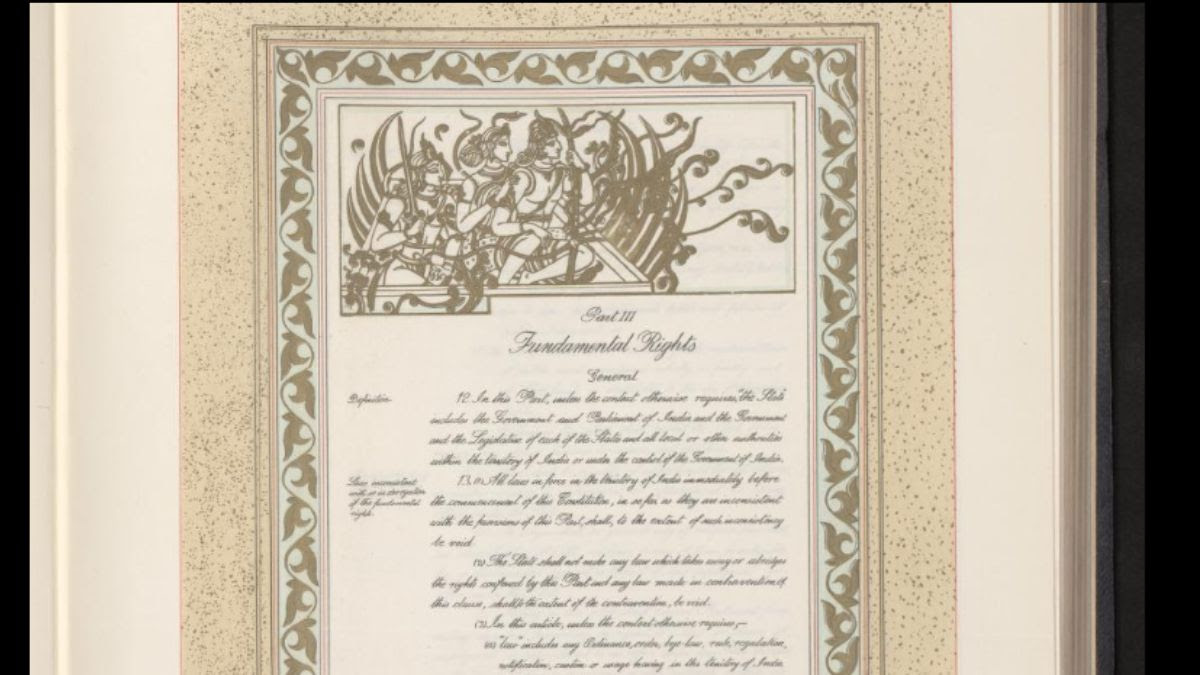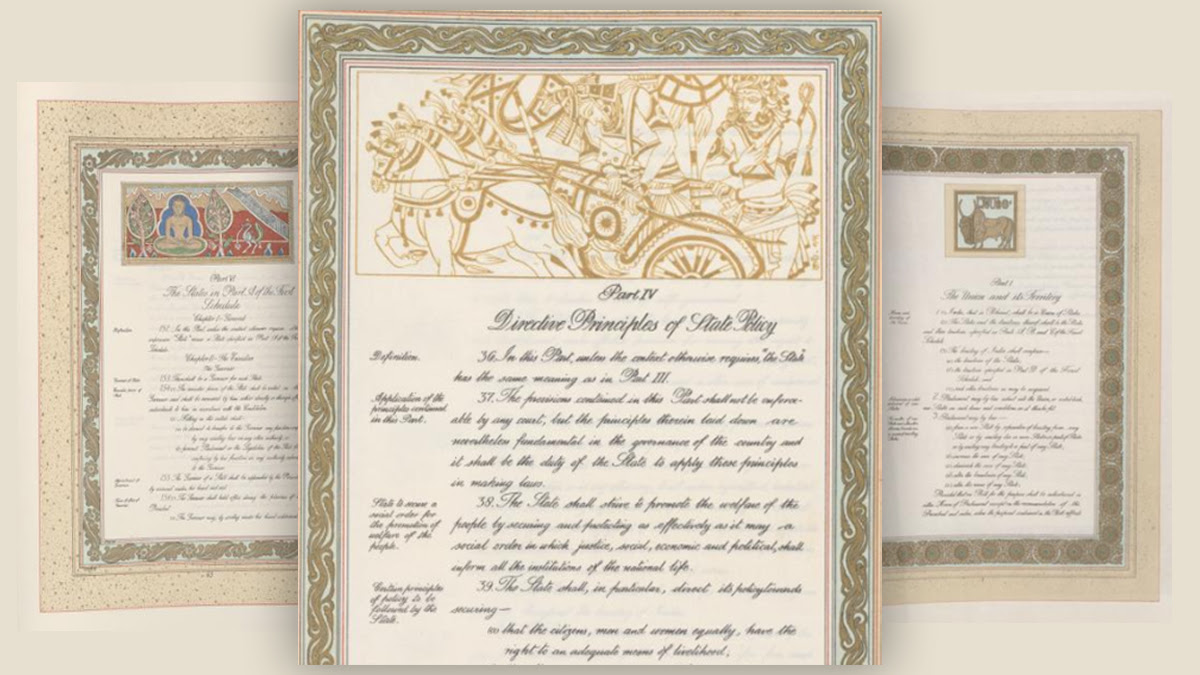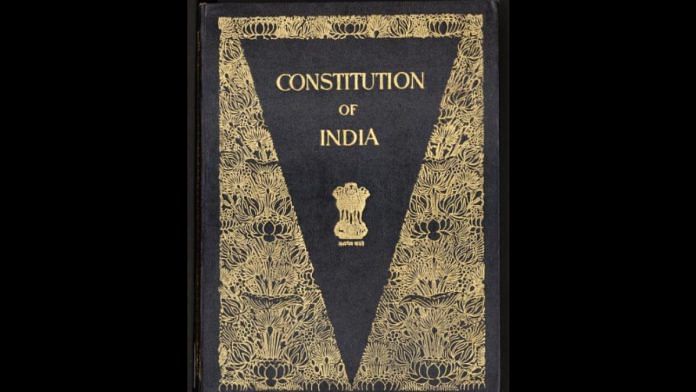New Delhi: On Sunday, Prime Minister Narendra Modi referred to paintings of Ram, Sita and Lakshman in the original copy of the Indian Constitution and claimed that “Prabhu Ram ka shashan” (the governance by Hindu deity Ram, ruler of Ayodhya according to the mythology Ramayana) was a source of inspiration for the makers of the country’s Constitution. However, notes and letters from 1949 and 1950 — the years when the Indian Constitution was adopted and came into effect — seen by ThePrint suggest that the paintings in the Constitution merely depict “scenes from Indian history, legend and life”.
“In part three of the original copy of this very Constitution, the fundamental rights of the citizens of India have been described and it is noteworthy that at the beginning of part three, the makers of our Constitution had allotted due space to the pictures of Bhagwan Ram, Mata Sita and Lakshmanji,” the Prime Minister was quoted as saying in his monthly radio program “Mann Ki Baat”.
He was referring to Part III of the Constitution on fundamental rights. The painting at the start of this part depicts Ram, his wife Sita and brother Lakshman returning to Ayodhya from Lanka, after a 14-year exile during which the deity is believed to have also fought and killed Lankan king Raavan, after he abducts his wife Sita.

“Prabhu Ram ka shashan (lord Ram’s rule) was also a source of inspiration for the makers of our Constitution and that is why on 22 January in Ayodhya, I had talked about ‘Dev se Desh’ [God to country]… I’d referred to ‘Ram se Rashtra’ [Ram to nation],” Modi further claimed.
The Constitution is divided into multiple parts and each part begins with horizontal line drawings on top of the page. The text of the Constitution was handwritten by calligrapher Prem Behari Narain Raizada, and the artwork was done by artist Nandalal Bose, along with his team.
Part I, dealing with the Union and its territory, begins with an image of the Bull Seal excavated from the Indus Valley region. Part IV, on the Directive Principles of State Policy has an illustration of Krishna and Arjun. Part XIV, dealing with Services under the Union and the states, has a drawing of Emperor Akbar with his courtiers.

Other parts include drawings of religious leaders, freedom fighters and former Indian rulers like Buddha, Mahavir, Maharani Laxmi Bai, Chhatrapati Shivaji, Guru Gobind Singh, Tipu Sultan, Guru Gobind Singh, Shivaji, Mahatma Gandhi and Subhas Chandra Bose.
Letters exchanged between Rajendra Prasad, president of the constituent assembly, and Nandalal Bose show that the idea behind the paintings was to make designs “covering the whole period of Indian civilisation”.
Also Read: The Republic is dead and no point blaming BJP-RSS. We need a new political language
The Nandalal letters
A brief note on the calligraphy of the Constitution of India, as published in the Parliament Secretariat in June 1950, offers more insight into the process of beautifying the original English and Hindi copies of the Constitution. It says that the “calligraphy and artistic decoration” of the original authoritative copy of the Constitution was undertaken on the suggestion of professor and member of constituent assembly, of K.T. Shah.
The president of the constituent assembly then wrote to Nandalal Bose on 21 October, 1949, explaining that they wanted to present to the first Parliament of India on 26 January 1950 an “illuminated manuscript of the entire Constitution”.
In the letter, seen by ThePrint, while he noted that the time was short as the printed version of the Constitution ran into about 300 pages, he added that “the task is worth doing inasmuch as the illuminated manuscript will be treasured by the nation and by the future generations as a monument not only of our political and intellectual labors but also of the nation’s artistic achievements”.
The letter also described the task at hand, saying that the margins in the manuscript are for the illustrations. “It has been suggested that significant scenes from Indian history, legend and life should be incorporated in the designs. It is an excellent suggestion and I should be very happy if it could be done,” he added.
According to the brief note, while Nandalal agreed to the president’s request, he “suggested that it would not be possible to make designs based on historical subjects, as suggested by the President, owing to shortage of space in the margin, and in the alternative agreed to make ornamental designs covering the whole period of Indian civilisation.”
Nandalal also concurred with the prime minister’s suggestion to avoid multi-colour illustrations and to have “real gold spray on the margins and beautiful border illumination in rectangular form”.
‘Indelible for 1,000 years’
A note dated 17 January, 1950, in the constituent assembly secretariat noted that the estimation that the calligraphy and the border-illustration work would be completed before 26 January, 1950, “has been upset”. It added that only half of the work would be done by that date and that the remaining work would take at least another month after 26 January, 1950.
An article, titled ‘Indelible for over 1,000 years’ published in the Indian Express on 26 January, 1950, then spoke of three copies of the Indian Constitution.
The article said that the Indian Constitution, which the members of the constituent assembly signed, was printed on vellum parchment papers and weighed over 40 lb. It added that “the historic document in English contains 289 pages for the Articles and Schedules and is expected to be indelible for over a thousand years.”
The article then spoke of two other volumes, handwritten by special calligraphists, which weren’t complete yet but had been signed by the members. “They contain pages whose borders are illuminated in gold-like Moghul paintings.”
These two volumes, one in English and the other in Hindi, were to be sent to Santiniketan, where under Nandalal’s direction, the first pages of each chapter and Schedules were to be painted “with pictures depicting various periods in Indian history”.
According to the brief note, since the work could not be completed by 26 January, 1950 — the date on which the Constituent Assembly ceased to function — it was transferred to the Parliament Secretariat to be completed under the direction of the then speaker of the Parliament.
Another note from the constituent assembly secretariat, dated 21 January, 1950, said that, while the work is “mostly a labor of love” for Nandalal, the payments to the artists working under him were a different matter. According to one of the notes while Bose had not asked for any amount, the president of the constituent assembly had offered payment for the work. A letter from the president of the constituent assembly, dated 25 January, 1950, said that Nandalal had so far asked only for the actual cost of material.
The initial brief note then said that the speaker, with the concurrence of the prime minister had then decided to pay as honorarium to the artists Rs 400 for the cover page, Rs 400 for the Preamble, Rs 200 for the beginning of the first part, Rs 100 for each ornamented illustration and Rs 50 for each intermediate page with plain decoration.
It was estimated that the total cost incurred in connection with the calligraphy, decoration and illumination, along with printing and binding of the two editions of the Constitution, would come to about Rs 1,80,000. These were the estimates in May 1950, but it is unclear as to the amounts that were paid for this work, and what cost was actually incurred.
Also Read: As TN takes ‘deadlock’ with Ravi to SC, what Constitution & court have said on governors’ powers
‘No special importance’
While there haven’t been too many court judgments mentioning these paintings, the Allahabad High Court in 1993, observed, “Here Rama, when we adopted him, and his life, as a part of our Constitutional theme to depict certain ideal, he became a constitutional entity, admittedly a reality of our National Culture and Fabric and not a myth.”
The court was hearing a petition filed by Vishwa Hindu Adhivakta Sangh — an association of Hindu advocates — demanding a direction to permit pooja and aarti at Ram Janmabhoomi in Ayodhya.
However, experts suggest against reading too much into these paintings.
Justice R.S. Chauhan also wrote in The Leaflet, a legal news portal, that one should not read too much between the lines when it comes to artwork in the Constitution.
Explaining what each of these artworks denotes, he wrote that the painting of Ram, Sita and Lakshman at the start of the fundamental rights chapter “does not mean that the Constitution proves the existence of Lord Ram as a historical figure. Far from it.”
He further explained that the depiction of the return of Ram to Ayodhya “may hint at the establishment of a new era, a new raj, but not necessarily a Ram Rajya as the modern narrative would have us believe”, pointing out that the fundamental rights were being recognised and acknowledged for the first time in the history of India.
Constitutional expert P.D.T. Achary reaffirmed that the idea behind these illustrations “was to depict Indian history in all its phases, starting from the Indus Valley to the freedom struggle”, and that “the idea was not to give any special importance or not to lay any special emphasis on anybody”.
Constitutional expert and vice-chancellor at Chanakya National Law University, Patna, professor Faizan Mustafa asserted that the paintings in the Constitution are “a narration of our history and civilizational story”.
He told ThePrint that he believes that Ram Rajya as a concept must have been in their minds, and said that to bring that “ideal state” to life, they adopted the best ideas from across the world to incorporate in the Constitution.
However, he added, “In interpreting the Constitution, you may not even be able to rely on them.”
(Edited by Richa Mishra)
Also Read: Article 16(4) stands on its own. Constitution made no room for ‘merit’ that courts invoke



